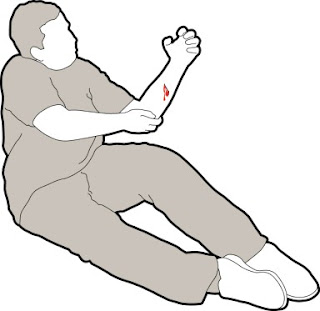21. Bifid (Bífido): divided into two lobes.
22. Bladder (Vejiga): In anatomy, the urinary bladder (roughly translated from vesicle) is a solid, muscular, and distensible (or elastic) organ that sits on the pelvic floor in mammals. It is the organ that collects urine excreted by the kidneys prior to disposal by urination. Urine enters the bladder via the ureters and exits via the urethra.

23. Blast Cell (Célula blástica): A white blood cell that fails to mature, multiplies rapidly, and crowds out normal blood cells; inhibits the ability of normal cells to effectively defend the body against microorganisms.
24. Bleb (Vesícula): is a large blister (usually approximately hemispherical) filled with serous fluid. Blebs can form in a number of tissues due to different pathologies, including frostbitten tissues, and as a cause of spontaneous pneumothorax. In the lungs, a bleb is a collection of air within the layers of the visceral pleura. In ophthalmology, blebs may be formed intentionally in the treatment of glaucoma.
25. Bleed (Sangrar): To lose blood through an injured blood vessel.
26. Blood (Sangre): is the red liquid that flows inside your body, which you can see if you cut yourself.
27. Brain (Cerebro): is the center of the nervous system in all vertebrate, and most invertebrate, animals.Brains can be extremely complex. The human brain contains roughly 100 billion neurons, linked with up to 10,000 synaptic connections each. Each cubic millimeter of cerebral cortex contains roughly one billion synapses.
28. Breast (Pecho): is the upper ventral region of an animal’s torso, particularly that of mammals, including human beings. The breasts of a female primate’s body contain the mammary glands, which secrete milk used to feed infants.
29. Cesarean (Cesárea): is a surgical procedure in which incisions are made through a mother's abdomen (laparotomy) and uterus (hysterotomy) to deliver one or more babies. It is usually performed when a vaginal delivery would put the baby's or mother's life or health at risk, although in recent times it has been also performed upon request for childbirths that could otherwise have been natural.

30. Calcaneus (Colcáneo): This word derives its name from the Latin word calx = chalk or limestone, perhaps from a fancied resemblance to that substance. The bone is also known as the os calcis or chalk bone.

22. Bladder (Vejiga): In anatomy, the urinary bladder (roughly translated from vesicle) is a solid, muscular, and distensible (or elastic) organ that sits on the pelvic floor in mammals. It is the organ that collects urine excreted by the kidneys prior to disposal by urination. Urine enters the bladder via the ureters and exits via the urethra.

23. Blast Cell (Célula blástica): A white blood cell that fails to mature, multiplies rapidly, and crowds out normal blood cells; inhibits the ability of normal cells to effectively defend the body against microorganisms.
24. Bleb (Vesícula): is a large blister (usually approximately hemispherical) filled with serous fluid. Blebs can form in a number of tissues due to different pathologies, including frostbitten tissues, and as a cause of spontaneous pneumothorax. In the lungs, a bleb is a collection of air within the layers of the visceral pleura. In ophthalmology, blebs may be formed intentionally in the treatment of glaucoma.

25. Bleed (Sangrar): To lose blood through an injured blood vessel.

26. Blood (Sangre): is the red liquid that flows inside your body, which you can see if you cut yourself.

27. Brain (Cerebro): is the center of the nervous system in all vertebrate, and most invertebrate, animals.Brains can be extremely complex. The human brain contains roughly 100 billion neurons, linked with up to 10,000 synaptic connections each. Each cubic millimeter of cerebral cortex contains roughly one billion synapses.

28. Breast (Pecho): is the upper ventral region of an animal’s torso, particularly that of mammals, including human beings. The breasts of a female primate’s body contain the mammary glands, which secrete milk used to feed infants.

29. Cesarean (Cesárea): is a surgical procedure in which incisions are made through a mother's abdomen (laparotomy) and uterus (hysterotomy) to deliver one or more babies. It is usually performed when a vaginal delivery would put the baby's or mother's life or health at risk, although in recent times it has been also performed upon request for childbirths that could otherwise have been natural.

30. Calcaneus (Colcáneo): This word derives its name from the Latin word calx = chalk or limestone, perhaps from a fancied resemblance to that substance. The bone is also known as the os calcis or chalk bone.



No hay comentarios:
Publicar un comentario